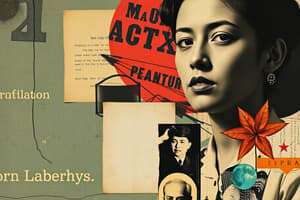Podcast
Questions and Answers
What are the poems all about?
What are the poems all about?
The content of the poems varies, typically exploring themes relevant to contemporary issues or personal experiences.
How are the poems alike and different?
How are the poems alike and different?
Poems may share thematic elements or forms but differ in style, perspective, and emotional impact.
What changes have you noticed in Philippine literary genres in the past and present?
What changes have you noticed in Philippine literary genres in the past and present?
There has been an increase in diversity and experimentation in forms and themes.
How do the changes in various literary genres in the Philippines improve the culture of the country?
How do the changes in various literary genres in the Philippines improve the culture of the country?
What is an illustrated novel?
What is an illustrated novel?
What does digifiction combine?
What does digifiction combine?
What is the definition of manga?
What is the definition of manga?
Flash fiction is defined as a style of fictional literature of great length.
Flash fiction is defined as a style of fictional literature of great length.
What is creative nonfiction?
What is creative nonfiction?
Flashcards are hidden until you start studying
Study Notes
21st Century Literature
- Explores various literary forms and genres, showcasing evolution in storytelling techniques and approaches.
- Illustrates changes in how narratives are presented, reflecting cultural shifts and technological advancements.
Illustrated Novels
- May feature little to no text, relying heavily on visual storytelling.
- Examples include "The Invention of Hugo Cabret" and "The Arrival," emphasizing interpretation of images alongside traditional text.
Digi-Fiction
- Combines three media: books, films/videos, and interactive websites.
- Requires active engagement across all platforms for a full story experience.
- Examples include "Skeleton Creek" and "Level 26," merging reading and multimedia elements.
Graphic Novels
- Narratives conveyed primarily through comic-style illustrations.
- Encompasses a wide range of content, from fictional stories to thematic anthologies.
- Notable example includes Archie Comics.
Manga
- Originally a Japanese term for comics, it represents a unique artistic storytelling form.
- Classified into genres, such as Shonen for boys (e.g., Naruto), Shojo for girls (e.g., Sailormoon), and others for different demographics.
Doodle Fiction
- Features handwritten text and illustrations, deviating from conventional font usage.
- Enhances narrative with humor and visual creativity.
- Example works include "The Diary of a Wimpy Kid" by Jeff Kinney.
Text-Talk Novels
- Narratives designed in a digital format, mimicking online communications like blogs and instant messaging.
- Primarily dialogue-driven, representing contemporary social interactions.
Flash Fiction
- Characterized by extreme brevity, lacking a standard length definition.
- Can range from a single word to approximately a thousand words, focusing on distilled storytelling.
Six-Word Flash Fiction
- A specific, ultra-concise format exemplified by works from authors like Ernest Hemingway.
- Illustrates the strength of minimalism in conveying profound or emotional themes.
Creative Non-Fiction
- Merges literary techniques with factual writing to create engaging narratives.
- Contrasts with traditional non-fiction forms, emphasizing storytelling skill alongside factual accuracy.
Studying That Suits You
Use AI to generate personalized quizzes and flashcards to suit your learning preferences.




